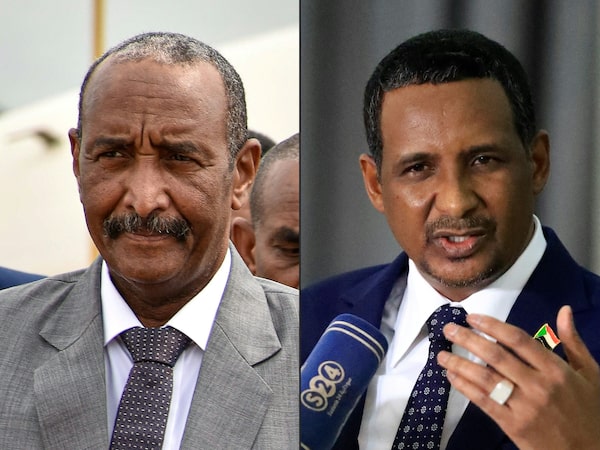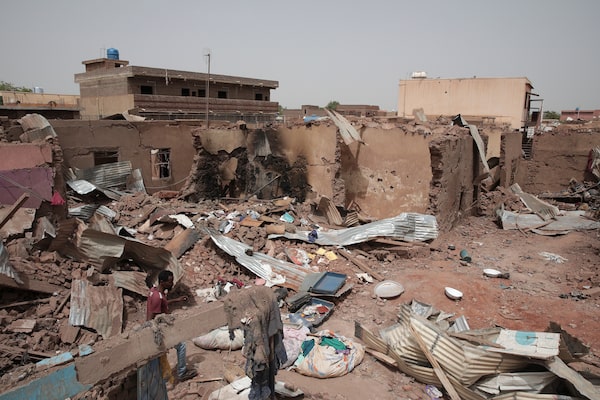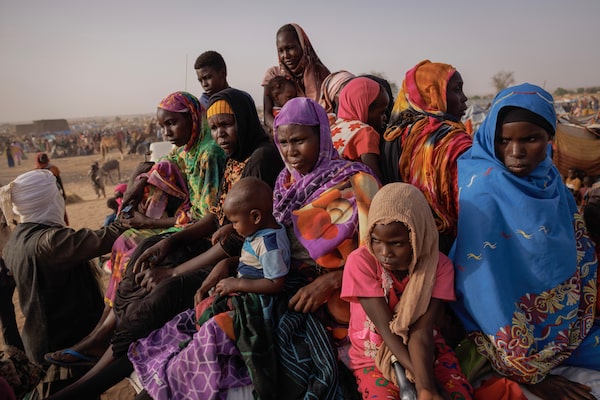Families displaced by RSF advances in Sudan's El Gezira and Sennar states shelter at the Omar ibn al-Khattab displacement site, Kassala state on July 10, 2024.Faiz Abubakr/Reuters
The catastrophic conflict in Sudan, now in its second year, has triggered the world’s worst displacement crisis, forcing more than 10 million people to flee their homes. With famine already underway in some parts of the country, it could soon lead to the world’s worst hunger crisis. And it has huge geopolitical implications, drawing in fighters and weapons from across Africa and the Middle East.
UN report documents Sudan atrocities and calls for peacekeeping force
The fighting erupted in Sudan on April 15, 2023, after weeks of tension between the Sudanese Armed Forces (SAF) and the powerful paramilitary group, the Rapid Support Forces (RSF).
Since then, the war has killed tens of thousands of civilians, spreading to dozens of towns and cities in most regions of Sudan. From the earliest weeks of the conflict, with artillery and tank fire crashing into Khartoum’s densely populated neighbourhoods, both sides have been destroying buildings and leaving hospitals crowded with dead and wounded. More than 16 months later, most of Sudan’s hospitals and clinics are in ruins or closed, schools are shut down, aid supplies are largely blocked, and mass hunger is growing.
How did the conflict begin? Who are the central figures involved? What’s at stake? Here’s what to know about the current situation in Sudan.
Why is there conflict in Sudan and what led to the recent violence?

Sudan's army chief, General Abdel Fattah al-Burhan, left, and Gen. Mohamed Hamdan Dagalo, who commands the paramilitary Rapid Support Forces.AKUOT CHOL/AFP/Getty Images
There are two sides in the war, led by two men – a career soldier and a former warlord – both of whom rose to power under former dictator Omar al-Bashir:
One side is the Sudanese Armed Forces, led by General Abdel Fattah al-Burhan.
The other warring party is the Rapid Support Forces, a paramilitary force led by General Mohamed Hamdan Dagalo.
The Sudanese military and the RSF united to seize power in 2019 by toppling Mr. Bashir during a wave of pro-democracy protests. They united again in 2021 when they launched another coup to block a planned transition to democratic elections. But the two sides soon fell into a power struggle.
Under heavy pressure from the United Nations and Western governments, Gen. Dagalo and Gen. Burhan signed a preliminary deal in December, 2022 to hand back power to a civilian-led government. During negotiations to reach a final agreement, however, two main disputes emerged: how the RSF would be integrated into the military and who would have ultimate control over fighters and weapons.
On April 15, 2023, their feud exploded into violence. The Sudanese military denounced the RSF as “rebels,” while Gen. Dagalo declared that Gen. Burhan would be captured dead or alive.
Both of the warring parties have close links to military forces in other countries in Africa and the Middle East, fuelling tensions across both regions.
What are the Rapid Support Forces (RSF)?
A member of the Sudanese Armed Forces walks between damaged buildings, almost one year into the war between the Sudanese Armed Forces and the paramilitary Rapid Support Forces (RSF), in Omdurman, Sudan, April 7, 2024.El Tayeb Siddig/Reuters
The RSF was created in 2013, evolving from its roots in the notorious Janjaweed militia that terrorized Darfur two decades ago. The paramilitary group was widely accused of massacres and other war crimes in Darfur in the early 2000s when Mr. Bashir deployed the militia to crush a rebellion in the region.
Gen. Dagalo, known in Sudan by his nickname Hemedti (Little Mohamed), is the commander of the RSF. For years he thrived on alliances with Sudan’s army, ascending to become deputy leader of Sudan’s military regime.
“Bashir created something that neither he nor anyone else in the government, including the regular army, could control,” Nicholas Coghlan, a former Canadian ambassador to Sudan, told The Globe and Mail. “Hemedti grew in influence and power. He acquired gold-mining interests in Darfur, which – as the economy went into freefall starting four years ago – has given him even more clout.”
The RSF has since expanded its presence across the country and currently has an estimated 100,000 fighters in its ranks, with reported links to Russian military contractors and the armies of several Gulf states.
Where in Sudan is the fighting happening?

A man walks by a house hit in fighting in Khartoum, Sudan, on Tuesday, April 25, 2023.Marwan Ali/The Associated Press
The fighting began in the centre of Khartoum, shutting down its main airport. The clashes quickly spread across the capital and the adjoining city of Omdurman, and then further south and west to Darfur and other places such as Kordofan region and Gezira state, which had previously been peaceful.
As the fighting expanded, many people have been forced to flee their homes multiple times. Camps for displaced people have been overrun or placed under siege.
Some of the worst surges of killing in the Sudan war have been in Darfur, which had endured earlier massacres by the Janjaweed from 2003 to 2007, when an estimated 300,000 people were killed, leading to genocide charges at the International Criminal Court.
What has been the human toll so far?
Displaced people sit inside a tent at a school turned into a shelter, in Port Sudan, Sudan, August 29, 2024.Abrahim Mohammed Ishac/Reuters
By official count, more than 20,000 people have been killed in Sudan’s war, but this is clearly a vast underestimate. The true death toll is impossible to calculate, but as many as 150,000 people may have been killed so far, according to U.S. envoy Tom Perriello.
Last year a UN report estimated that 10,000 to 15,000 people had been massacred in a single city in Darfur during a wave of ethnically targeted killings by the RSF and its allied militias. Mass killings have been reported in many other places, and the fighting has been devastating in Khartoum and elsewhere.
Sexual violence, perpetrated by soldiers and paramilitary forces, is equally widespread. The UN says it received “credible information” that more than 160 women and girls were abducted and held in captivity in Sudan, including many who were raped or kept in slave-like conditions. Some reports said women and girls abducted in Khartoum State were taken to Darfur, allegedly in chains in the back of trucks. In almost all cases, RSF elements or affiliated militia were implicated.
More than 10 million people across Sudan have been forced to flee their homes since the war began, making Sudan the worst displacement crisis in the world. Of those who fled, nearly two million have crossed borders to neighbouring countries, putting a huge burden on already fragile states.

Newly arrived refugees from Darfur in Sudan, sit on a vehicle before being taken to a new camp on April 23, 2024 in Adre, Chad.Dan Kitwood/Getty Images
Civilians are also suffering from hunger, malnutrition and lack of health care. More than 25 million people – over half of Sudan’s population – are in need of emergency aid. More than eight million people in Sudan are facing emergency levels of hunger, and 3.6 million children are acutely malnourished, with 500,000 already officially in famine at a refugee camp in North Darfur. Some Sudanese are sustained only by a few mouthfuls of sorghum a day. At a health centre in South Darfur, four to five children are dying of malnutrition every day, relief workers say.
Many aid groups are finding it almost impossible to reach the worst-hit areas of the country, where 90 per cent of the neediest people are located, largely because of obstacles by the two warring sides. Sudan is one of the world’s most dangerous and difficult places to deliver aid, they say. Dozens of aid workers have been killed and many warehouses have been looted.
The UN has warned of a catastrophe for an entire generation of children. An estimated 19 million children have been out of the school for the past year, and nearly four million children are suffering acute malnutrition.
The crisis is worsened by the collapse of Sudan’s health system. Only 20 to 30 per cent of the country’s hospitals and clinics are still functional. Many were looted or heavily damaged by fighters.
What kinds of ceasefire negotiations have taken place?
There have been many ceasefire attempts so far in Sudan, but all have been broken. The first ceasefire attempts were led by the United Nations in the early days of the war. Later rounds of negotiations were organized by the United States and Saudi Arabia. None has led to any significant reduction in the fighting.
The latest negotiations were held near Geneva in August. But the Sudanese military did not even bother to accept the invitation to the talks, and there was no progress towards a ceasefire.
What’s at stake for the region?
The war in Sudan has huge implications for Africa and the Middle East. The flow of refugees from Sudan has had a major impact on several African countries, but the war has also been heavily influenced by geopolitical connections. There is growing concern that the war is being fuelled by weapons from foreign suppliers, especially the United Arab Emirates, which is widely accused of sending weapons to the RSF.
The fact that the two warring parties have sustained their combat for more than a year “is in no small part thanks to the support they receive from outside of Sudan,” senior UN official Rosemary DiCarlo told the UN Security Council. A recent UN fact-finding mission called for the existing arms embargo (covering only Darfur) to be expanded to the entire country.
What is Canada doing? What about other countries?
Foreign Affairs Minister Mélanie Joly speaks with reporters in the Foyer of the House of Commons about the situation in Sudan, Thursday, April 27, 2023 in Ottawa.Adrian Wyld/The Canadian Press
When the war first erupted, Western governments were focused mainly on evacuating their own citizens, including their diplomats. For weeks, their main effort was to send airplanes into Sudan to get their citizens out. Since then, besieged Sudanese citizens have criticized Western governments for failing to take stronger action to seek an end to the war. Aside from a few sanction decisions and humanitarian funding, the West has done little.
The United States, Britain and the European Union were quick to impose sanctions on a handful of individuals and corporations with links to the two warring sides. Canada was much slower to react, but Foreign Affairs Minister Mélanie Joly finally announced Canada’s first sanctions in the Sudan war on April 15, imposing penalties on six Sudanese individuals and companies that she blamed for undermining peace in the country.
The Canadian sanctions – including asset freezes – were imposed on individuals and companies that have links to the two warring parties, the SAF and RSF. The individuals will also be barred from entering Canada.
Canada and other countries have provided hundreds of millions of dollars to relief agencies operating in Sudan. But less than half of the US$2.7-billion goal for the humanitarian relief effort in Sudan this year has been funded so far.
Canada has also announced a family reunification plan to bring 3,250 Sudanese to Canada, but the plan has been slow to get underway.